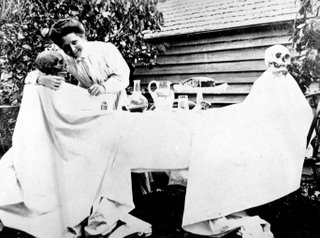 Boreham Family Photos
Boreham Family PhotosHelen, a regular reader of this site, asked a question about the availability of photographs of the Boreham family. Her question has prompted this posting and some others to follow. I mentioned to her that there are portraits of Frank Boreham in many of his books and My Pilgrimage contains one of his wife Stella. Boreham tried to keep his wife (The Mistress of the Manse) and his children out of his books. Apart from his autobiography he is very restrained in writing about what he gets up to.
Life Through a Lens
“The photographs hanging here and there around the room transport my mind
to
other days and other places .... the pictures transform it [the
apartment] into
an observatory and I am able to survey the entire
universe."
F.W. Boreham, Rubble and Roseleaves
For F.W. Boreham there were no uninteresting subjects, only uninterested persons. He had an observant eye which took in every detail and stored them in an unusually retentive memory. It was as if he saw life through a camera lens which concentrates on its subject and ignores the rest.
In recent years, some boxes of glass negatives that were taken and developed by F.W. Boreham have come to light and are now part of the Tasmanian Baptist historical records. Among the plates are shots of the Hobart Tabernacle and its officers, many family pictures, scenes of his much loved Wedge Bay on the Tasman Peninsula and some trick photography which includes a portrayal of a ghost on the steps of the Hobart manse! I will continue to post these on this site.
His children, Joan Lincoln of Hobart and Frank Boreham of Templestowe, remember their father's hooded camera requiring a black sheet so that the image could be clearly seen in the glass plate on top of the camera and the shutter was operated by a length of string. In this way and by using a tripod, Dr. Boreham took several self-portraits and group photographs with him in the frame. Joan and Frank remember their father developing the glass plate negatives in the cellar under the Armadale Baptist church manse. The cellar had a small window which he covered with red paper when making prints. Once he started work the children were not allowed in. [Joan and Frank junior are now dead but these insights were passed on to me when I interviewed them in the mid 1990s]
Photographer and editor of the Tasmanian Baptist Advance, Laurie Rowston says:
"Boreham's photographic work is all the more compelling when we consider that the business of photography in the early years of the twentieth century was a very different affair to that of the present day. There were no point-and-shoot automatic cameras then. A photographer needed a high degree of skill which included knowing how to measure the light and develop and print the film. All this before even considering what he wanted to photograph. Boreham must have been a perfectionist because he chose to use a photographic method (the dry glass plate) which was far more complex than what was being offered when he commenced and which became popular. In taking photographs Boreham also became a wordless writer. But more importantly his photographs, like his books, make you see."
(These notes are adapted from an article written by Laurie Rowston for the Tasmanian Baptist Advance. Appreciation is expressed to Laurie for his willingness for this to be reprinted).
Geoff Pound
Image: Boreham’s photo of his wife and two ghosts!? He found these human skulls on the Otago (NZ) beach of Taieri Mouth and kept them through his Tasmanian days.


